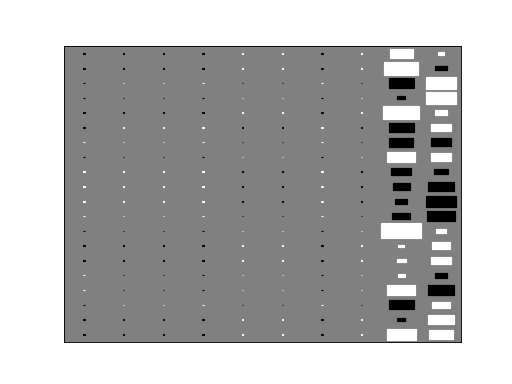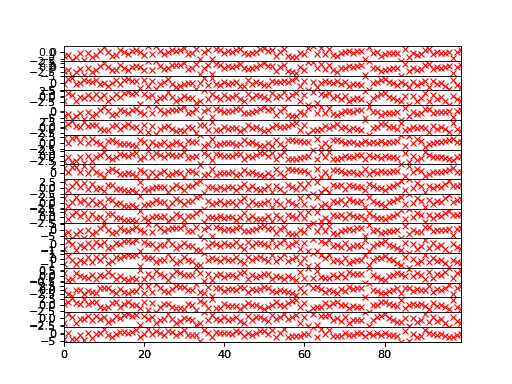Principal component analysis¶
This example uses a simple principal component analysis to find a two-dimensional latent subspace in a higher dimensional dataset.
Data¶
Let us create a Gaussian dataset with latent space dimensionality two and some observation noise:
>>> M = 20
>>> N = 100
>>> import numpy as np
>>> x = np.random.randn(N, 2)
>>> w = np.random.randn(M, 2)
>>> f = np.einsum('ik,jk->ij', w, x)
>>> y = f + 0.1*np.random.randn(M, N)
Model¶
We will use 10-dimensional latent space in our model and let it learn the true dimensionality:
>>> D = 10
Import relevant nodes:
>>> from bayespy.nodes import GaussianARD, Gamma, SumMultiply
The latent states:
>>> X = GaussianARD(0, 1, plates=(1,N), shape=(D,))
The loading matrix with automatic relevance determination (ARD) prior:
>>> alpha = Gamma(1e-5, 1e-5, plates=(D,))
>>> C = GaussianARD(0, alpha, plates=(M,1), shape=(D,))
Compute the dot product of the latent states and the loading matrix:
>>> F = SumMultiply('d,d->', X, C)
The observation noise:
>>> tau = Gamma(1e-5, 1e-5)
The observed variable:
>>> Y = GaussianARD(F, tau)
Inference¶
Observe the data:
>>> Y.observe(y)
We do not have missing data now, but they could be easily handled with mask
keyword argument. Construct variational Bayesian (VB) inference engine:
>>> from bayespy.inference import VB
>>> Q = VB(Y, X, C, alpha, tau)
Initialize the latent subspace randomly, otherwise both X and C would
converge to zero:
>>> C.initialize_from_random()
Now we could use VB.update() to run the inference. However, let us first
create a parameter expansion to speed up the inference. The expansion is based
on rotating the latent subspace optimally. This is optional but will usually
improve the speed of the inference significantly, especially in high-dimensional
problems:
>>> from bayespy.inference.vmp.transformations import RotateGaussianARD
>>> rot_X = RotateGaussianARD(X)
>>> rot_C = RotateGaussianARD(C, alpha)
By giving alpha for rot_C, the rotation will also optimize alpha
jointly with C. Now that we have defined the rotations for our variables,
we need to construct an optimizer:
>>> from bayespy.inference.vmp.transformations import RotationOptimizer
>>> R = RotationOptimizer(rot_X, rot_C, D)
In order to use the rotations automatically, we need to set it as a callback function:
>>> Q.set_callback(R.rotate)
For more information about the rotation parameter expansion, see [7] and [6]. Now we can run the actual inference until convergence:
>>> Q.update(repeat=1000)
Iteration 1: loglike=-2.33...e+03 (... seconds)
...
Iteration ...: loglike=6.500...e+02 (... seconds)
Converged at iteration ...
Results¶
The results can be visualized, for instance, by plotting the Hinton diagram of the loading matrix:
>>> import bayespy.plot as bpplt
>>> bpplt.pyplot.figure()
<matplotlib.figure.Figure object at 0x...>
>>> bpplt.hinton(C)
(Source code, png, hires.png, pdf)

The method has been able to prune out unnecessary latent dimensions and keep two components, which is the true number of components.
>>> bpplt.pyplot.figure()
<matplotlib.figure.Figure object at 0x...>
>>> bpplt.plot(F)
>>> bpplt.plot(f, color='r', marker='x', linestyle='None')
(Source code, png, hires.png, pdf)

The reconstruction of the noiseless function values are practically perfect in
this simple example. Larger noise variance, more latent space dimensions and
missing values would make this problem more difficult. The model construction
could also be improved by having, for instance, C and tau in the same
node without factorizing between them in the posterior approximation. This can
be achieved by using GaussianGammaISO node.